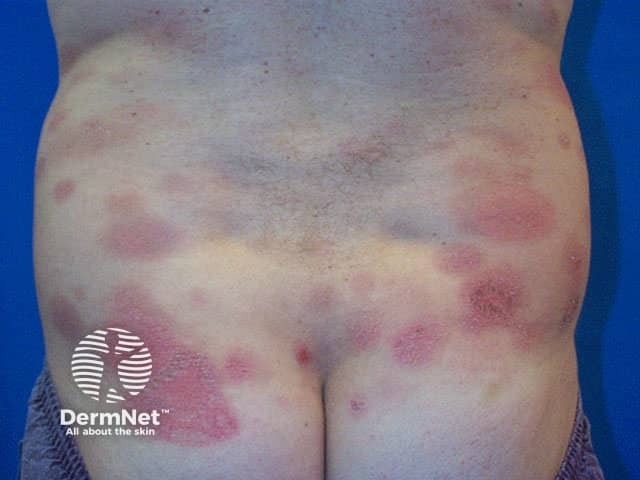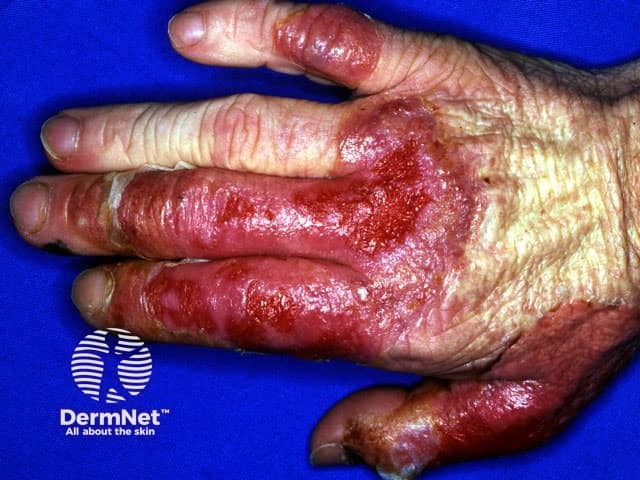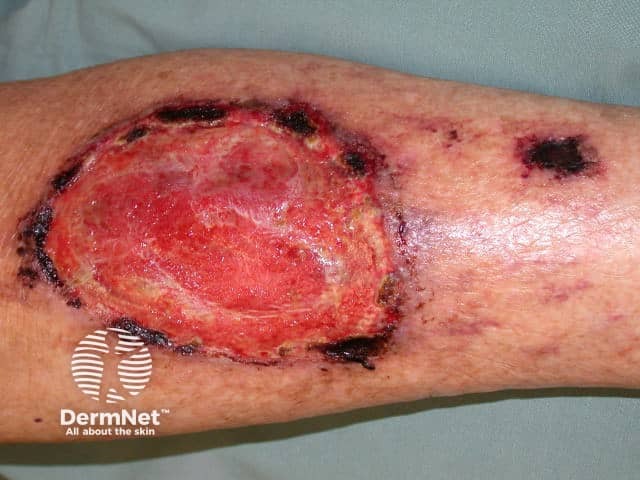Main menu
Common skin conditions

NEWS
Join DermNet PRO
Read more
Quick links
Created 2008.
Dermatoses with dense dermal infiltrates of neutrophils include:
Neutrophilic dermatoses are probably mediated through helper T cell type 1 cytokines (IL-2, INF-γ) rather than helper T cell type 2 cytokines (IL-4). This results in the stimulation of a cytokine cascade, which might be responsible for the local and systemic activation of neutrophils and histiocytes.
Acute febrile neutrophilic dermatosis or Sweet disease presents acutely as a rash accompanied by systemic symptoms. The skin lesions are rapidly evolving juicy often ‘pseudo-vesicular’ plaques or nodules accompanied by fever, leukocytosis, conjunctivitis and arthralgia. The lesions are most often located asymmetrically on the upper extremities, neck and face and may be painful. There may also be oral ulcers.
Acute febrile neutrophilic dermatosis arising on the back of the hands is sometimes called pustular vasculitis.
Acute febrile neutrophilic dermatosis may be idiopathic, or arise in association with:
Sweet disease Sweet disease Pustular vasculitis 


Pyoderma gangrenosum is associated with inflammatory bowel disease, rheumatoid arthritis and haematological malignancies but occasionally arises in otherwise healthy individuals.
Pyoderma gangrenosum results in acute and often severe ulceration characterised by an overhanging purple or black necrotic edge and severe pain. It most commonly arises on the lower legs but may appear on any site. It heals with cribriform scarring but may be very difficult to control.
Superficial bullous PG Pyoderma gangrenosum Pyoderma gangrenosum 


Full blood count shows neutrophilia (and sometimes myelogenous leukaemia). Acute febrile neutrophilic dermatosis may be associated with an acute infection, so other investigations will depend on symptoms.
Skin biopsy characteristically shows:
Diagnosis is made clinically. A skin biopsy is generally used to rule out other causes of skin ulceration. In pyoderma gangrenosum, the biopsy characteristically shows:
Direct immunofluorescence is generally negative.
It is important to culture a swab and if necessary, tissue from the ulcer for bacteria including slow growing mycobacteria and fungi.
Acute febrile neutrophilic dermatosis may spontaneously resolve within two or three months, or more promptly with treatment of underlying infection or on withdrawal of the causative drug.
Treatment may also include:
These medications are usually very effective and only required for a few weeks. Sweet disease may however recur, in which case the treatment may be repeated.
Pyoderma gangrenosum often requires one or more systemic immune suppressive medications and may recalcitrant to all drugs. Treatment may include:
Find out which drugs can precipitate acute febrile neutrophilic dermatosis.
Information for patients
See the DermNet bookstore